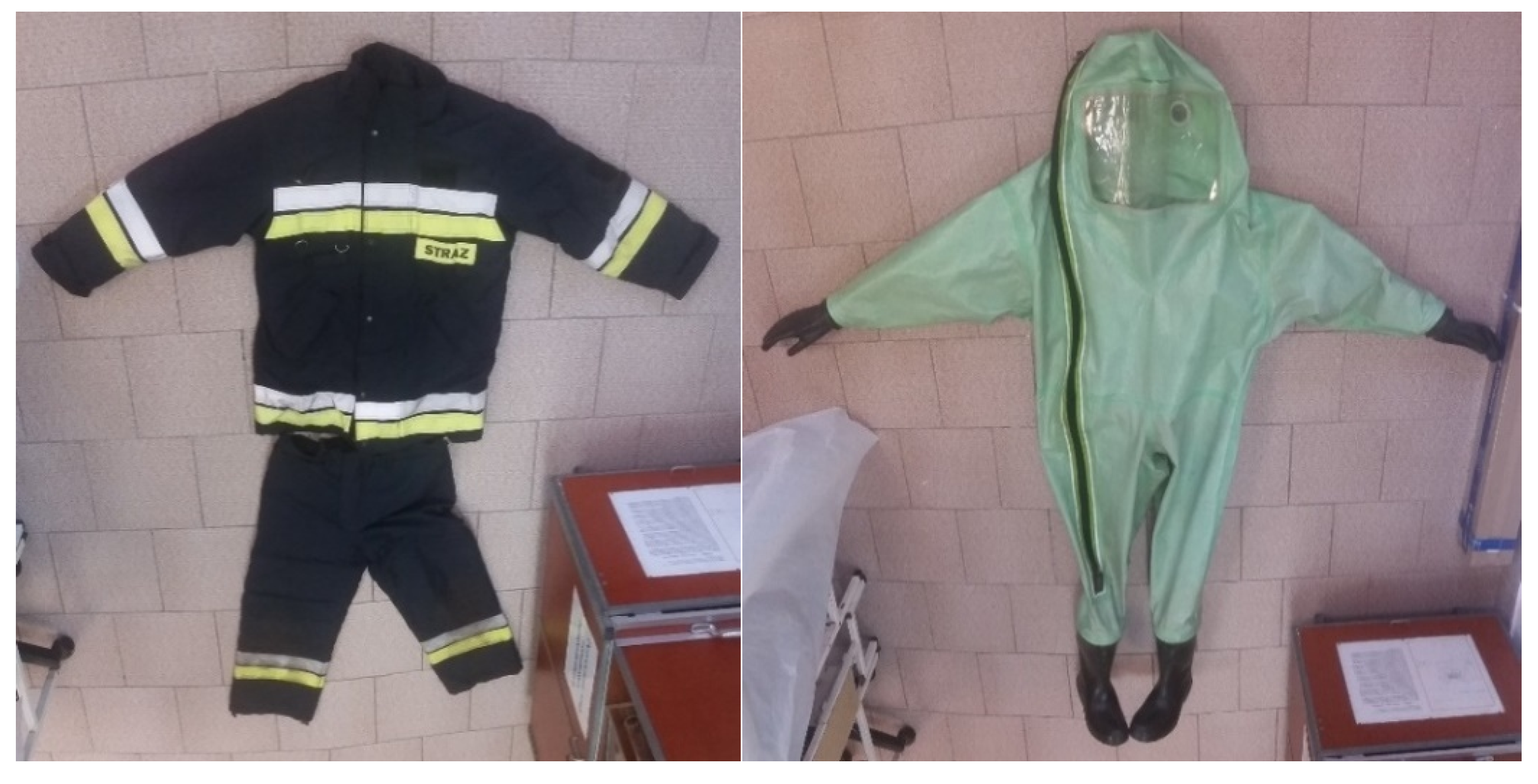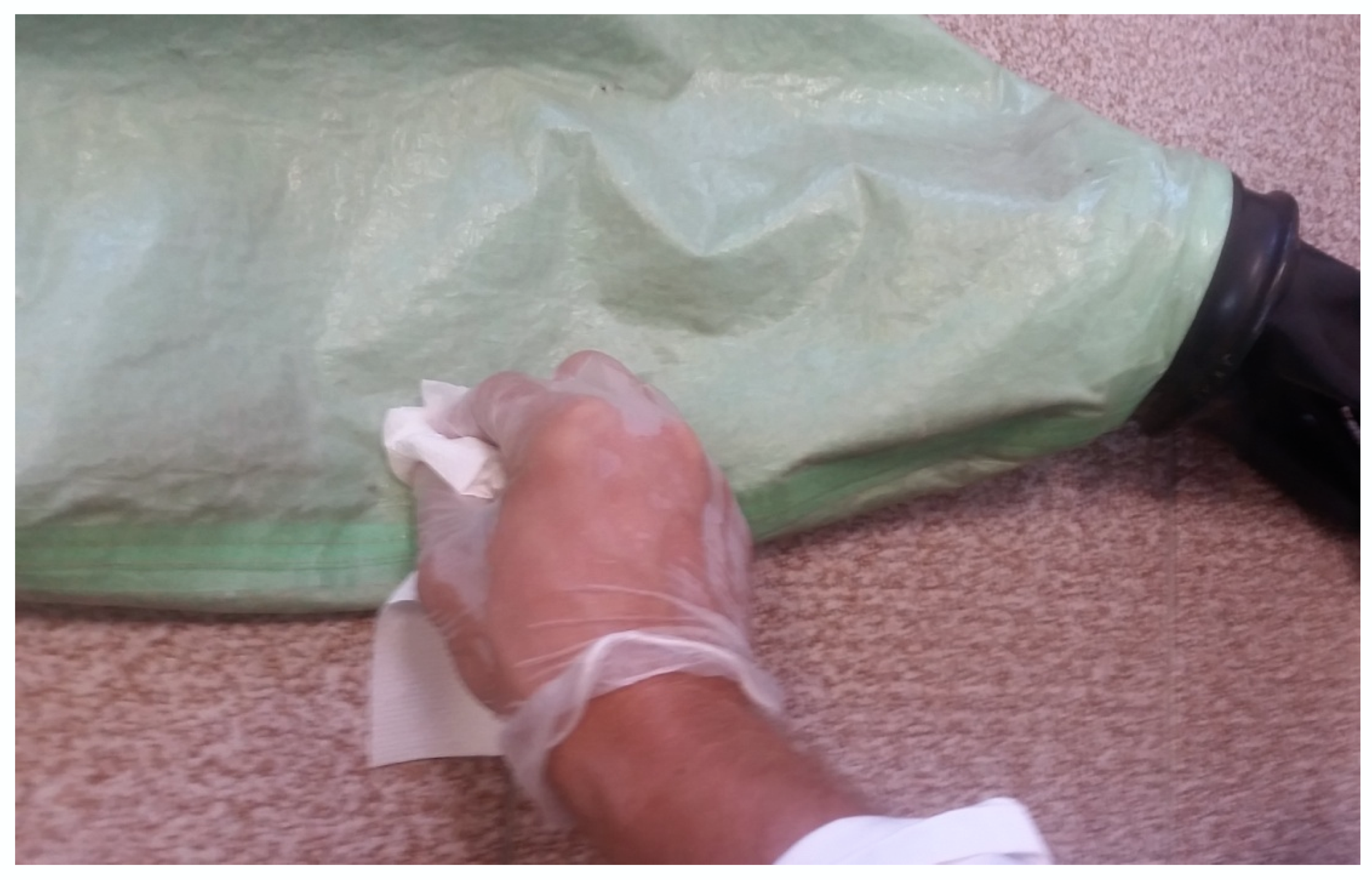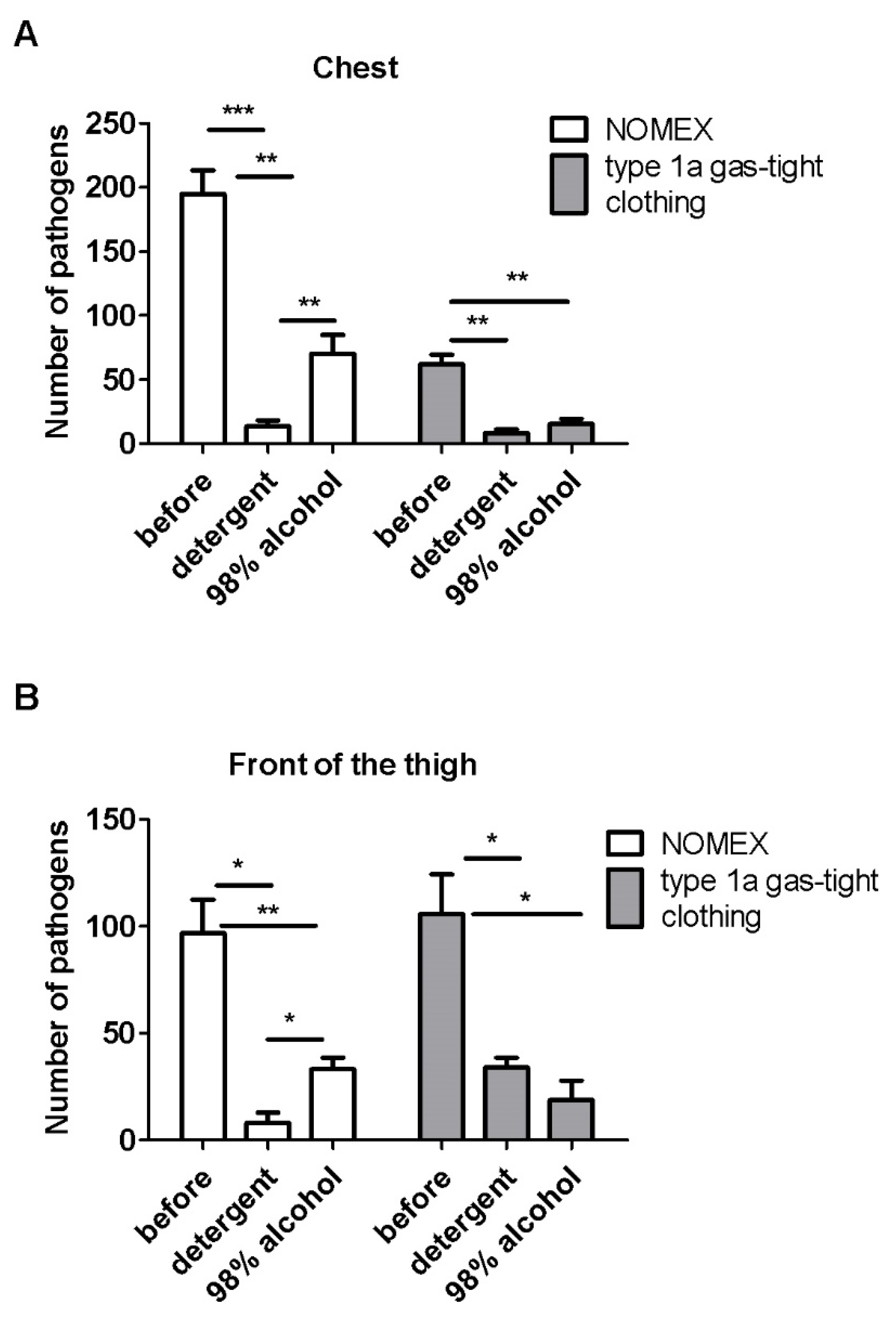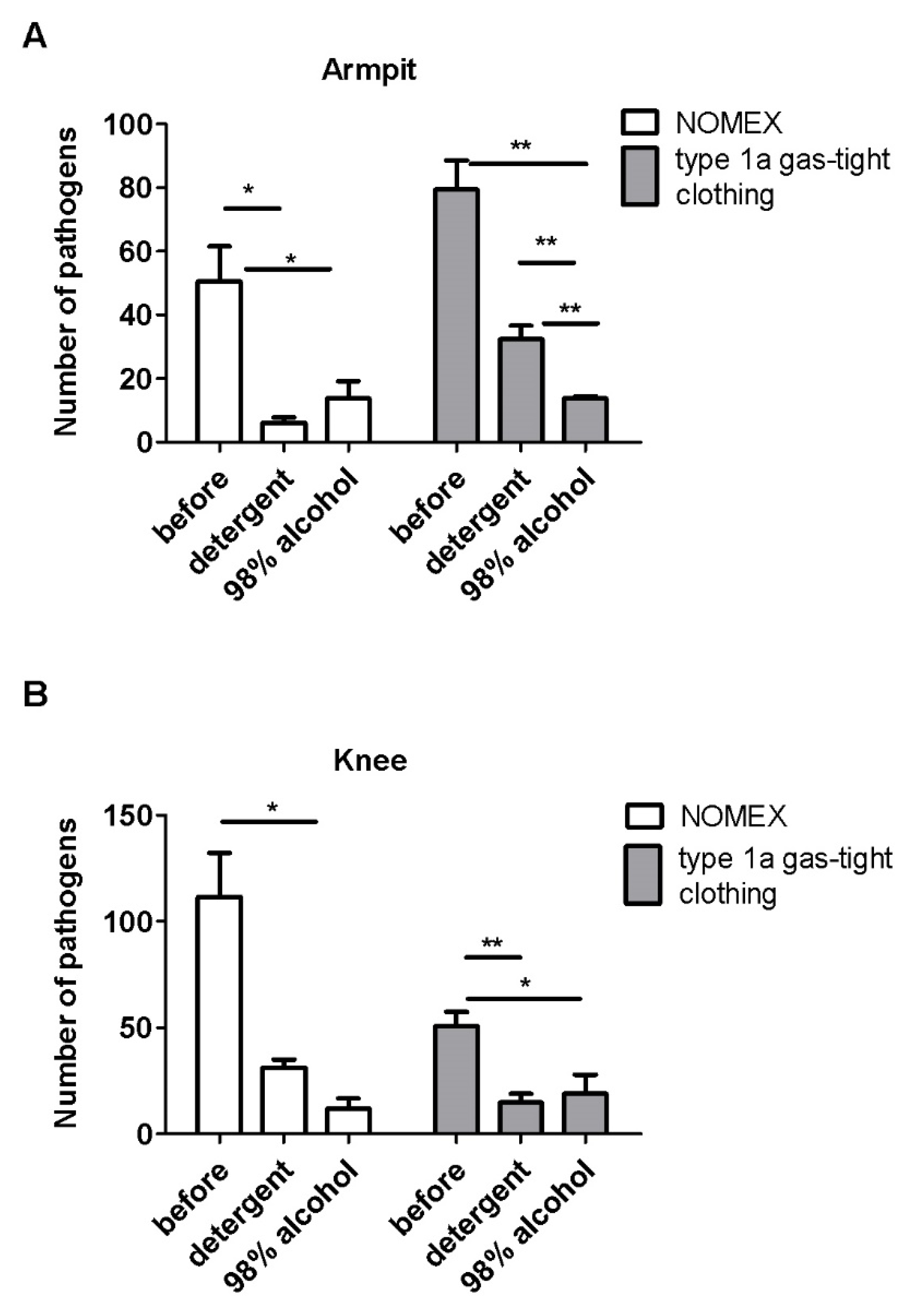Analysis of the Effectiveness of Decontamination Fluids on the Level of Biological Contamination of Firefighter Suits
Abstract
1. Introduction
2. Materials and Methods
2.1. Sample Collection
2.2. Gram Staining
2.3. Statistical Analysis
3. Results
4. Discussion
Limitation to the Study
5. Conclusions
Author Contributions
Funding
Acknowledgments
Conflicts of Interest
References
- Stewart, I.B.; Stewart, K.L.; Worringham, C.J.; Costello, J.T. Physiological tolerance times while wearing explosive ordnance disposal protective clothing in simulated environmental extremes. PLoS ONE 2014, 9, e83740. [Google Scholar] [CrossRef] [PubMed]
- Dreger, R.W.; Jones, R.L.; Petersen, S.R. Effects of the self-contained breathing apparatus and fire protective clothing on maximal oxygen uptake. Ergonomics 2006, 49, 911–920. [Google Scholar] [CrossRef] [PubMed]
- McLellan, T.M.; Boscarino, C.; Duncan, E.J. Physiological strain of next generation combat uniforms with chemical and biological protection: Importance of clothing vents. Ergonomics 2013, 56, 327–337. [Google Scholar] [CrossRef] [PubMed]
- Polanczyk, A.; Majder-Lopatka, M.; Salamonowicz, Z.; Dmochowska, A.; Jarosz, W.; Matuszkiewicz, R.; Makowski, R. Environmental Aspects of Sorption Process. Annu. Set Environ. Prot. 2018, 20, 13. [Google Scholar]
- Polanczyk, A.; Salamonowicz, Z. Computational modeling of gas mixture dispersion in a dynamic setup–2d and 3d numerical approach. E3S Web Conf. 2018, 44, 8. [Google Scholar] [CrossRef]
- Havenith, G.; den Hartog, E.; Martini, S. Heat stress in chemical protective clothing: Porosity and vapour resistance. Ergonomics 2011, 54, 497–507. [Google Scholar] [CrossRef]
- Gonzalez, N.W.; Bernard, T.E.; Carroll, N.L.; Bryner, M.A.; Zeigler, J.P. Maximum sustainable work rate for five protective clothing ensembles with respect to moisture vapor transmission rate and air permeability. J. Occup. Environ. Hyg. 2006, 3, 80–86. [Google Scholar] [CrossRef]
- Horn, G.P.; Kesler, R.M.; Kerber, S.; Fent, K.W.; Schroeder, T.J.; Scott, W.S.; Fehling, P.C.; Fernhall, B.; Smith, D.L. Thermal response to firefighting activities in residential structure fires: Impact of job assignment and suppression tactic. Ergonomics 2018, 61, 404–419. [Google Scholar] [CrossRef]
- Harrison, T.R.; Muhamad, J.W.; Yang, F.; Morgan, S.E.; Talavera, E.; Caban-Martinez, A.; Kobetz, E. Firefighter attitudes, norms, beliefs, barriers, and behaviors toward post-fire decontamination processes in an era of increased cancer risk. J. Occup. Environ. Hyg. 2018, 15, 279–284. [Google Scholar] [CrossRef]
- Costello, J.T.; Stewart, K.L.; Stewart, I.B. Inside the ‘Hurt Locker’: The Combined Effects of Explosive Ordnance Disposal and Chemical Protective Clothing on Physiological Tolerance Time in Extreme Environments. Ann. Occup. Hyg. 2015, 59, 922–931. [Google Scholar] [CrossRef]
- Alexander, B.M.; Baxter, C.S. Flame-retardant contamination of firefighter personal protective clothing—A potential health risk for firefighters. J. Occup. Environ. Hyg. 2016, 13, D148–D155. [Google Scholar] [CrossRef] [PubMed]
- Mayer, A.C.; Fent, K.W.; Bertke, S.; Horn, G.P.; Smith, D.L.; Kerber, S.; La Guardia, M.J. Firefighter hood contamination: Efficiency of laundering to remove PAHs and FRs. J. Occup. Environ. Hyg. 2019, 16, 129–140. [Google Scholar] [CrossRef] [PubMed]
- Polanczyk, A.; Salamonowicz, Z.; Majder-Lopatka, M.; Dmochowska, A.; Jarosz, W.; Matuszkiewicz, R.; Makowski, R. 3D Simulation of Chlorine Dispersion in Rrural Area. Annu. Set Environ. Prot. 2018, 20, 14. [Google Scholar]
- Polanczyk, A.; Ciuka-Witrylak, M.; Synelnikov, O.; Loik, V. Analysis of sorption of vehicle liquids with sand that appear after car accidents reproduced in laboratory scale. MATEC Web Conf. 2018, 247, 8. [Google Scholar] [CrossRef][Green Version]
- Caldwell, J.N.; Patterson, M.J.; Taylor, N.A. Exertional thermal strain, protective clothing and auxiliary cooling in dry heat: Evidence for physiological but not cognitive impairment. Eur. J. Appl. Physiol. 2012, 112, 3597–3606. [Google Scholar] [CrossRef] [PubMed]
- Fernando, S.; Shaw, L.; Gallea, D.; VandenEnden, L.; House, R.; Verma, D.K.; Britz-McKibbin, P.; McCarry, B.E. Evaluation of firefighter exposure to wood smoke 3 during training exercises at burn houses. Environ. Sci. Technol. 2016, 50, 1536–1543. [Google Scholar] [CrossRef] [PubMed]
- Ribeiro, M.; de Paula Santos, U.; Bussacos, M.A.; Terra-Filho, M. Prevalence and risk of asthma symptoms among firefighters in Sao Paulo, Brazil: A population-based study. Am. J. Ind. Med. 2009, 52, 261–269. [Google Scholar] [CrossRef]
- Fent, K.W.; Eisenberg, J.; Snawder, J.; Sammons, D.; Pieil, J.D.; Stiegel, M.A.; Mueller, C.; Horn, G.P.; Dalton, J. Systemic Exposure to PAHs and Benzene in Firefighters Suppressing Controlled Structure Fires. Ann. Occup. Hyg. 2014, 58, 16. [Google Scholar]
- Baxter, C.S.; Hoffman, J.D.; Knipp, M.J.; Reponen, T.; Haynes, E.N. Exposure of firefighters to particulates and polycyclic aromatic hydrocarbons. J. Occup. Environ. Hyg. 2014, 11, D85–D91. [Google Scholar] [CrossRef]
- Fent, K.W.; Alexander, B.; Roberts, J.; Robertson, S.; Toennis, C.; Sammons, D.; Bertke, S.; Kerber, S.; Smith, D.; Horn, G. Contamination of firefighter personal protective equipment and skin and the effectiveness of decontamination procedures. J. Occup. Environ. Hyg. 2017, 14, 801–814. [Google Scholar] [CrossRef]
- Calvillo, A.; Haynes, E.; Burkle, J.; Schroeder, K.; Calvillo, A.; Reese, J.; Reponen, T. Pilot study on the efficiency of water-only decontamination for firefighters’ turnout gear. J. Occup. Environ. Hyg. 2019, 16, 199–205. [Google Scholar] [CrossRef] [PubMed]
- Polanczyk, A. The usefulness of Gram staining method for analysis of the effectiveness of decontamination of firefighter’s protective outfit. MATEC Web Conf. 2018, 247. [Google Scholar] [CrossRef]
- Dorman, L.E.; Havenith, G. The effects of protective clothing on energy consumption during different activities. Eur. J. Appl. Physiol. 2009, 105, 463–470. [Google Scholar] [CrossRef] [PubMed]
- Czernicka, L.; Grzegorczyk, A.; Marzec, Z.; Antosiewicz, B.; Malm, A.; Kukula-Koch, W. Antimicrobial Potential of Single Metabolites of Curcuma longa Assessed in the Total Extract by Thin-Layer Chromatography-Based Bioautography and Image Analysis. Int. J. Mol. Sci. 2019, 20, 898. [Google Scholar] [CrossRef]
- Bera, T.; Xu, J.; Alusta, P.; Fong, A.; Linder, S.W.; Torosian, S.D. Estimating Bacterial Concentrations in Fibrous Substrates Through a Combination of Scanning Electron Microscopy and ImageJ. Anal. Chem. 2019, 91, 4405–4412. [Google Scholar] [CrossRef]






© 2020 by the authors. Licensee MDPI, Basel, Switzerland. This article is an open access article distributed under the terms and conditions of the Creative Commons Attribution (CC BY) license (http://creativecommons.org/licenses/by/4.0/).
Share and Cite
Polanczyk, A.; Piechota-Polanczyk, A.; Dmochowska, A.; Majder-Lopatka, M.; Salamonowicz, Z. Analysis of the Effectiveness of Decontamination Fluids on the Level of Biological Contamination of Firefighter Suits. Int. J. Environ. Res. Public Health 2020, 17, 2815. https://doi.org/10.3390/ijerph17082815
Polanczyk A, Piechota-Polanczyk A, Dmochowska A, Majder-Lopatka M, Salamonowicz Z. Analysis of the Effectiveness of Decontamination Fluids on the Level of Biological Contamination of Firefighter Suits. International Journal of Environmental Research and Public Health. 2020; 17(8):2815. https://doi.org/10.3390/ijerph17082815
Chicago/Turabian StylePolanczyk, Andrzej, Aleksandra Piechota-Polanczyk, Anna Dmochowska, Malgorzata Majder-Lopatka, and Zdzislaw Salamonowicz. 2020. "Analysis of the Effectiveness of Decontamination Fluids on the Level of Biological Contamination of Firefighter Suits" International Journal of Environmental Research and Public Health 17, no. 8: 2815. https://doi.org/10.3390/ijerph17082815
APA StylePolanczyk, A., Piechota-Polanczyk, A., Dmochowska, A., Majder-Lopatka, M., & Salamonowicz, Z. (2020). Analysis of the Effectiveness of Decontamination Fluids on the Level of Biological Contamination of Firefighter Suits. International Journal of Environmental Research and Public Health, 17(8), 2815. https://doi.org/10.3390/ijerph17082815






